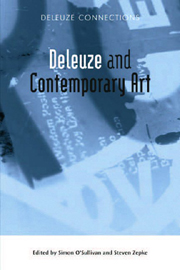Book contents
- Frontmatter
- Contents
- Acknowledgements
- List of Illustrations
- Introduction: Deleuze and Guattari and Contemporary Art
- POLITICS
- 1 The Politics of the Scream in a Threnody
- 2 A Shift Towards the Unnameable
- 3 The Heterogenesis of Fleeing
- 4 Anita Fricek: Contemporary Painting as Institutional Critique
- THE AESTHETIC PARADIGM
- SCENES AND ENCOUNTERS
- TECHNOLOGIES
- Notes on Contributors
- Index
1 - The Politics of the Scream in a Threnody
from POLITICS
Published online by Cambridge University Press: 12 September 2012
- Frontmatter
- Contents
- Acknowledgements
- List of Illustrations
- Introduction: Deleuze and Guattari and Contemporary Art
- POLITICS
- 1 The Politics of the Scream in a Threnody
- 2 A Shift Towards the Unnameable
- 3 The Heterogenesis of Fleeing
- 4 Anita Fricek: Contemporary Painting as Institutional Critique
- THE AESTHETIC PARADIGM
- SCENES AND ENCOUNTERS
- TECHNOLOGIES
- Notes on Contributors
- Index
Summary
We do not feel ourselves outside of our time but continue to undergo shameful compromises with it. This feeling of shame is one of philosophy's more powerful motifs. We are not responsible for the victims but responsible before them.
Gilles Deleuze and Félix Guattari, What is Philosophy?Deleuze is interested in the scream. He asks about the importance of the scream when he thinks about Francis Bacon's painting. How to paint the scream? It is about making visible, not just a particular sound, but those invisible forces that make it come about. The same problem arises with music, it is Alban Berg who knew how to ‘make music out of the scream’ and he put the sonority of the scream in a relationship with the soundless forces of the Earth, as with Marie's scream in Wozzeck and with the soundless forces of Heaven in Lulu (Deleuze 2002: 60). In cinema, Straub and Huillet value the scream; it becomes both a speech act and an act of resistance (Deleuze 1987: 289). Which movement of art will make the scream an act of resistance, and take us from the aesthetics to the politics of the scream?
This text will revolve around Colombian artist Clemencia Echeverri's work Treno. From the Greek threnos, meaning lament, and oide, meaning song, Treno is, quite precisely, a funeral song, an audiovisual threnody. This funeral song ends with a scream, what Deleuze calls a ‘cry against death’ (Deleuze 2002: 61). It is not about picking an artwork as a paradigmatic example in order to think the relationship between Deleuze and contemporary art, so that we can comfort ourselves with the application of a number of his concepts to the interpretation of such work.
- Type
- Chapter
- Information
- Deleuze and Contemporary Art , pp. 15 - 33Publisher: Edinburgh University PressPrint publication year: 2010



